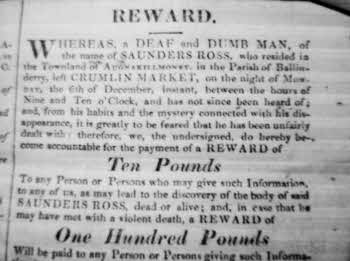
The Murder that never was
THE DIGGER

Part of a newspaper cutting used to rebind the old 19th century bible making reference to a reward for information relating to the disappearance of Saunders Ross in December 1830.
In a previous article I made reference to the early 19th century bible that an old friend of mine had salvaged from a dump in the Lisburn area many years ago. It had been rebound using old newspapers from the era, on of which was the story of the “body snatching” episodes at Lambeg Parish Church. I had briefly made reference to the other cutting found in the spine of the bible referring to a reward for information leading to the discovery of a man called Saunders Ross. He could neither hear nor speak and his disappearance was most upsetting to members of his family and to those who knew him.
An advertisement had been placed in the local press in December 1830. It states that Saunders was from the townland of “Aughnakillmoney” in the Parish of Ballinderry. The townland name is most likely the one that is now called Aughanamoney. There are many spelling variants of the name throughout the years. If you turn off the main Moira Road (A26) towards Lough Neagh at Lower Road, Ballinderry you will meet the Scroggy Road, part of which is situated in the Aughanamoney townland. In earlier maps the name “Ross Vale” appears on a property in the area. The Ross family were associated with the general area for generations.
Every townland has a tale to tell, and Aughanamoney would be no exception.
Saunders Ross had been last seen leaving Crumlin Market on the evening of Monday the 6th December, 1830 between nine and ten o’clock. The advertisement stated “from his habits and the mystery connected with his disappearance, it is greatly to be feared that he has been unfairly dealt with.” Family and friends must have feared the worst. They were offering a ten pounds reward to anyone who gave information that would lead to the “discovery of the body....dead or alive, and, in case that he may have met with a violent death, a reward of one hundred pounds will be paid...” In 1831 those were substantial amounts of money, and it would not be long before a witness would come forward with information.
He was called James Kerr, later described as a “very ill-looking fellow, and blind of one eye.” He, shortly after the appeal for information, appeared before Crumlin magistrates and swore on oath that he had seen brothers William and John Davison strangling Saunders Ross in a field off a public road in the village of Crumlin. He told James McAuley, the magistrate, that he saw them put the body in a sack and carry it off. A strange set of circumstances, but of course this was during the “body-snatching” era and an event like this could not be dismissed especially when William Davison, one of the accused, was a surgeon!
The Davisons were arrested and subsequently committed for trial. It would not be long before the actual truth of the disappearance of Saunders Ross would come to light.
The advertisement that had been circulated in the press had undoubtedly been read the length and breadth of Ireland. It was reported that on the 1st February a letter was received from a man called Charles Canavan, a driver of the “Derry mail coach.” He gave information contradictory to what the belief in the local district had been. He stated that Saunders Ross was in fact in Londonderry and he described where he might be located there. As a result of this information Saunders Ross was “restored to his friends.”
On Saturday, March 26th 1831 James Kerr was indicted at Carrickfergus, for wilful and corrupt perjury. James McAuley the magistrate to whom he had given the false information gave evidence against the accused. Allen Ross, a brother of Saunders, gave evidence to the court that the accused had approached him whilst he was posting hand-bills in Crumlin and he told him of the murder. It was reported that Allen Ross told Kerr to go to the magistrate and he added that he claimed to have warned him of the dangers of untruths in respect of his allegation. Saunders Ross, described as a thin man about sixty years of age, was produced to the court. William Davison, one of the alleged murderers, told the court that on the day in question he was not near the scene of the alleged murder nor was he is anyone’s company on the road leading to the place. There could be no doubt as to the real truth of the matter.
The Northern Whig reported that the jury “without a moment’s hesitation” returned a guilty verdict and James Kerr was found guilty of wilful and corrupt perjury. The sentence at that time was deferred. James Kerr would not have to wait too long for his sentencing. The Belfast Newsletter dated 5th April 1831 reported on the sentence. His dishonesty and greed on this occasion would see him spend a month in prison and seven years transportation.
The Digger can be contacted by email diggerarticle@hotmail.com
PHOTO CAPTION: Part of a newspaper cutting used to rebind the old 19th century bible making reference to a reward for information relating to the disappearance of Saunders Ross in December 1830.
14/03/2012
